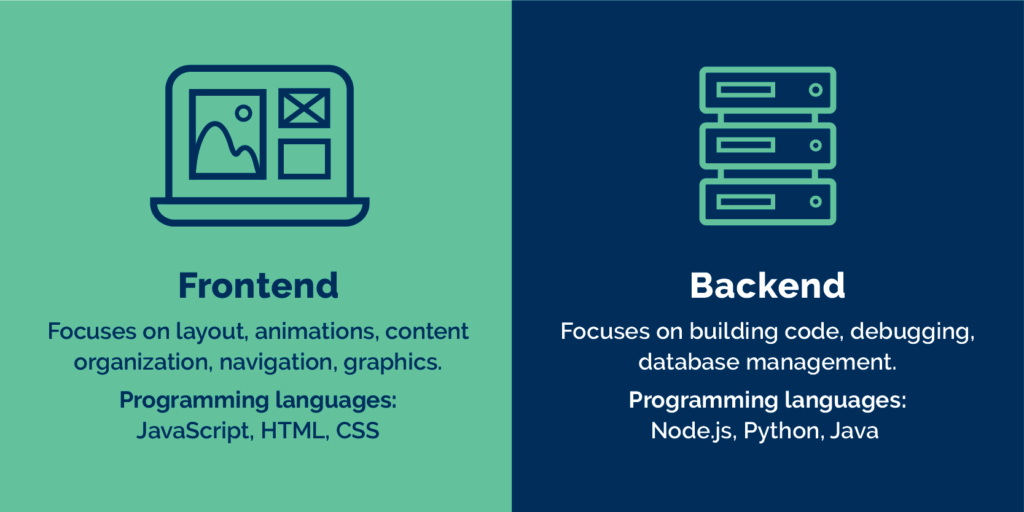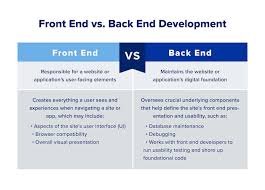Backend development and frontend development What’s the difference? This is among the most frequently asked questions by those who are new to the web development world. The digital age is based on websites apps, software, and experiences that are fluid, easy to use, speedy and visually amazing. However, behind every application are two important pillarsthe the frontend as well as backend design. Each has a distinct role, yet they function as two parts of a complete system. In this entertaining SEO-optimized guide, we’ll explain the essential information you need regarding their roles and qualifications technology, job responsibilities workflows, and the upcoming developments. There are no links in the guide only clear, optimized, and relevant content that is in line with EEAT and 2025’s SEO guidelines.
Introduction
When you visit a website the entire thing you see – including layout, colors buttons, images, forms, animations — is the result that happens on frontend. frontend. However, everything else you don’t see including user authentication, data processing storage for databases servers security -is what’s happening in part of the the backend. Imagine a set for a movie The frontend includes the actors and costumes, lighting and the visuals. The backend includes the crew of cameras technicians, camera crew, and directors who work on the back end to create the movie take place.
Understanding the distinction between backend and frontend development is not just helpful for beginners to make the right choice for their career and also provides businesses with the knowledge of which developer they require for their digital products.
In this article, we will look at:
- How do you define frontend development?
- How do you define backend development?
- There are some key differences between the two
- Responsibilities and roles
- Frameworks, tools and other technologies
- Essential skills
- Salary growth and career advancement
- How do they collaborate
- Which one should you study?
- Future trends for 2025 and beyond
Let’s start our journey in cinema!
What is Frontend Development?

Frontend development refers to the process of creating every interaction a user has through a web-based or mobile application. It’s about creating your user’s interface (UI) and providing an exceptional UX (UX). The frontend determines the way your site appears, feels as well as performs.
If you click the button or scroll down a webpage or hover over an animation, or fill in the form — it’s all frontend development at work.
The Goal of Frontend
To design an appealing, visually appealing quick, user-friendly, and fast web site that works with every device and browser.
A good frontend developer is a designer who behaves like an engineer and behaves as an UX strategist.
What is Backend Development?
Development of the backend can be described as an hidden engine that runs a site behind the scenes. While the frontend is focused on graphics, the backend concentrates on the logic, data servers, security and communications among systems.
Every time you log into your account, load your customized dashboard, buy something online, or store your data The backend is performing the heavy lifting.
The Goal of Backend
To build a secure, flexible, and efficient system that correctly processes data and sends the right information directly to the front end.
A backend developer is the head of the projectsolving problems, assuring stability, and directing the complex logic.
Key Differences Between Frontend and Backend Development

While both are in collaboration however, their roles as well as the tools and processes are completely different. This is a good example of a clear distinction:
1. Purpose
- Frontend The frontend is the UI that users will see.
- Backend handles APIs, databases, server, as well as the logic
2. Visibility
- Frontend It is visible to users.
- Backend: Completely hidden
3. Technologies
- Frontend: HTML, CSS, JavaScript, React, Vue
- Backend: Node.js, PHP, Python, Java, .NET, Databases
4. Skills
- Frontend: Design mind, UI/UX skills, responsive layout
- Backend: Problem-solving, security, data management
5. Tools
- Frontend: Figma, Tailwind, Git, Webpack
- Backend: SQL, Docker, API development, Server tools
6. Output
- Frontend: Stylish, responsive website
- Backend: Secure, functional system
Roles & Responsibilities of a Frontend Developer
Frontend developers are responsible for all things visually and interactive.
Core Responsibilities
- Converting UX/UI designs into useful websites
- Writing HTML to structure
- Designing using CSS to create layouts and styles
- Interactivity can be added using JavaScript
- Optimizing website performance
- Making mobile-responsive pages
- Testing frontends on browsers and devices
- Enhancing accessibility
- Implementing UI animations
- Utilizing APIs to retrieve data from the backend
Soft Skills
- Creativity
- Attention to detail
- Understanding user behavior
- Teamwork and communication
Roles & Responsibilities of a Backend Developer
Backend developers are focused upon the logic as well as the foundation for the entire system.
Core Responsibilities
- Designing database structures
- Writing server-side logic
- Managing APIs
- Integration with third-party services
- Handling authentication & authorization
- Security measures must be taken to ensure your security
- Optimizing servers to increase speed
- Backup of data and encryption
- Debugging backend errors
- Maintaining the application architecture
Soft Skills
- Analytical thinking
- Confidence in complex logic
- Ability to solve problems quickly
- Precision and patience
Technologies Used in Frontend Development
1. Core Languages
- HTML – Skeleton of the web site
- CSS – Layout, design and responsiveness
- JavaScript Interactivity and logic
2. Frameworks and Libraries
- React
- Vue
- Angular
- Svelte
3. CSS Frameworks
- TailwindCSS
- Bootstrap
- Material UI
4. Tools
- Git & GitHub
- Webpack
- Vite
- NPM/Yarn
5. UI/UX Tools
- Figma
- Adobe XD
- Sketch
Technologies Used in Backend Development
1. Programming Languages
- Node.js (JavaScript)
- PHP
- Python
- Java
- Ruby
- .NET
2. Databases
- MySQL
- MongoDB
- PostgreSQL
- Oracle DB
- Firebase
3. Frameworks
- Express.js
- Django
- Laravel
- Spring
- Ruby on Rails
4. Essential Tools
- Docker
- Git
- Redis
- Nginx
- Apache
- Postman
5. Cloud & Server Technologies
- AWS
- Azure
- Google Cloud
How Frontend and Backend Work Together
Backend and frontend interact constantly to provide a seamless experience.
Example:
- You click Login
- Frontend sends the details to backend
- Backend checks your account
- Backend responds in a successful or failed manner
- Frontend shows your dashboard
Both are extremely connectedWithout frontend, users are unable to view anything. Without backend, there is nothing to function.
Which One Is Easier?
This is based on your individual passion:
Frontend is simpler if you are a fan of:
- Designing
- Colors, layouts and UX
- Creative work
- Instant visual results
Backend is simpler to use if you are a fan of:
- Logic
- Data
- Problem-solving
- Security
- Systems for building
The two options are equally effective; they are effective and highly-in-demand career options.
Career Opportunities
Both of these fields provide many job prospects.
Frontend Developer Jobs
- UI Developer
- React Developer
- Web Designer + Developer
- Frontend Engineer
Backend Developer Jobs
- Backend Engineer
- API Developer
- Database Engineer
- DevOps (with previous experience)
Salary Comparison
On a global average:
- Frontend developers: In high demand and high pay
- Backend developers: More complex – slightly more wages
However, salary is contingent on the qualifications, experience, and the location.
Future Trends in 2025 and Beyond
Frontend Trends
- AI-assisted UI creation
- Motion UI
- 3.0 and immersive experiences. 3.0 and amazing experiences
- Component-based design is everywhere.
- Faster frameworks like SolidJS
Backend Trends
- Serverless architecture
- AI-driven data processing
- Microservices
- API-first development
- A greater emphasis on cybersecurity
The future is the responsibility of developers who are able to see both sides of the coin — the growth of the full-stack developer is more evident than ever before.
Should You Learn Frontend or Backend First?
If you’d like to select one of these:
Learn Frontend First if:
- You enjoy visuals
- You are interested in designing and building interactive interfaces
- You want quick results
Learn Backend First if:
- You enjoy logic
- You love solving deep problems
- You’d like to be involved in architecture and systems
Most developers eventually master both.
Full-Stack Development: The Best of Both Worlds
A full-stack developer has the ability to be a part of the frontend as well as the backend. This makes them extremely useful on jobs.
The power of full-stack:
- You can create complete applications
- More job openings
- More attractive salaries and packages
- Control of the entire flow of project
Conclusion
Frontend and backend development What’s the difference? The easiest answer is frontend is the way that users experience and backend creates how it functions. Both are crucial and require a certain amount of skill and both provide exciting opportunities for growth in your career. If you decide to go with frontend, backend or full-stack tech’s future has endless possibilities. Start with what you love, start with a small amount, continue to learn and keep up-to-date with the latest developments.




